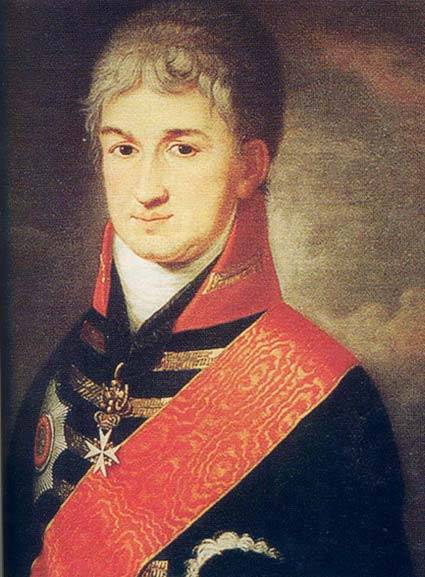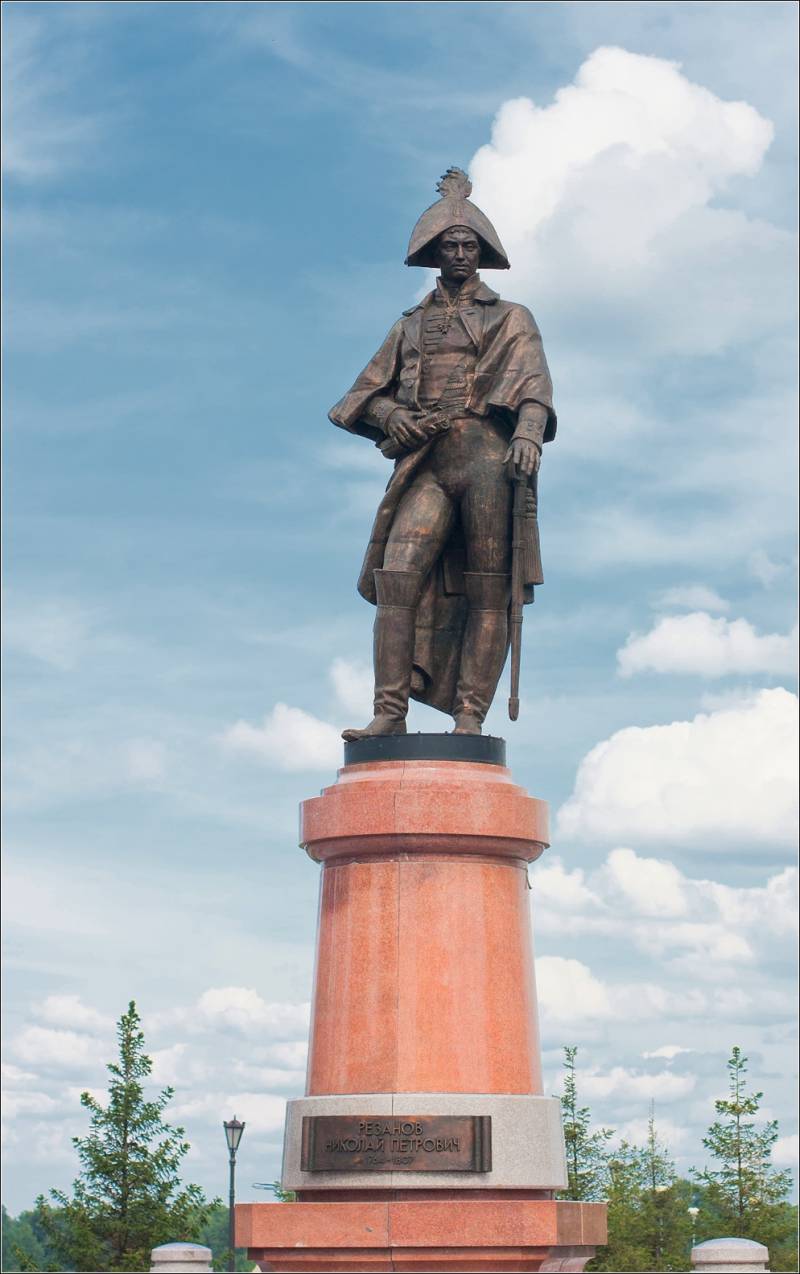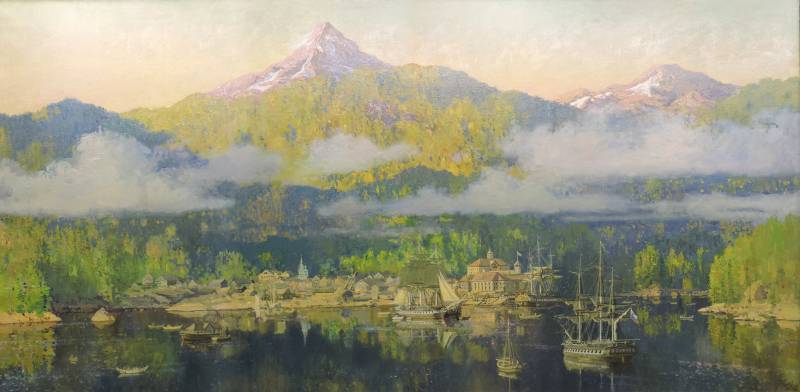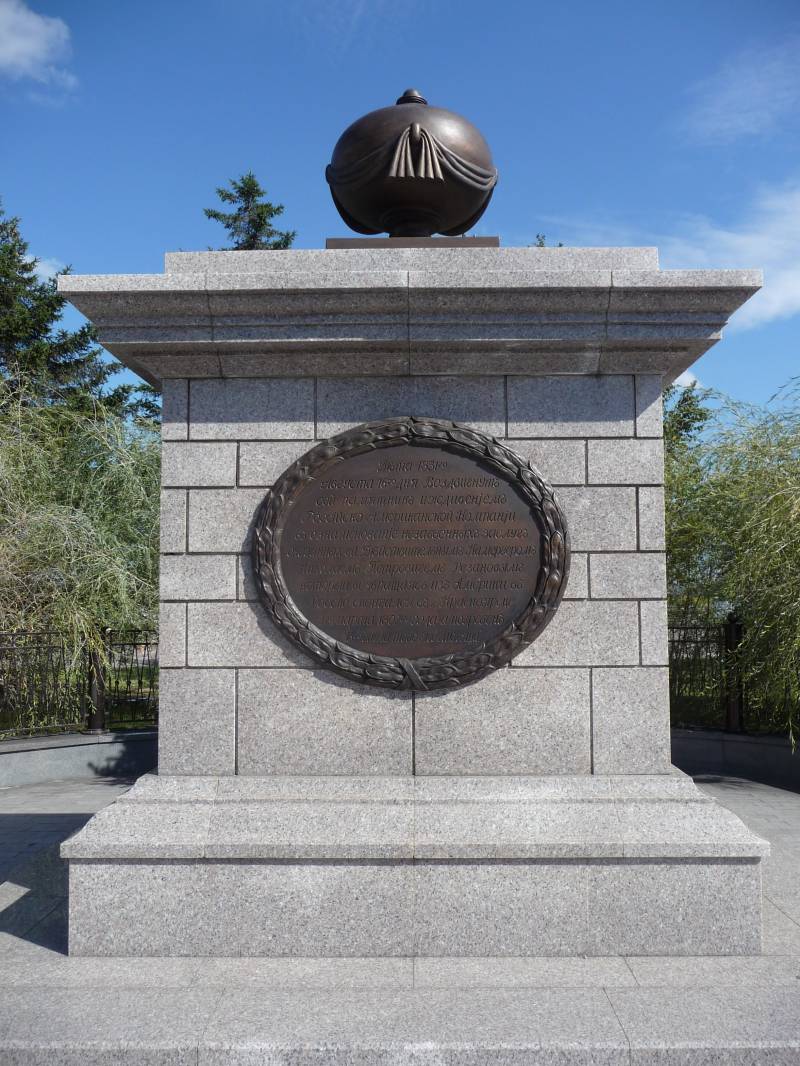Russian diplomat and traveler Nikolai Petrovich Rezanov
The future Russian diplomat was born in St. Petersburg 28 in March 1764, in a poor noble family. His father, Peter Gavrilovich Rezanov, was a collegiate adviser, and his mother, Alexander Rezanov, was the daughter of Major-General G. A. Okunev. His father was unable to gain a foothold in the capital, but was assigned to Irkutsk, the then capital of Eastern Siberia, the vast territories stretching from the Yenisei to the Pacific Ocean. Here he was offered the post of chairman of the civil chamber of the provincial court.
Not much is known about Nikolai Rezanov’s childhood. It is noted that he received a very good home education. At the same time, Nikolay had a great linguistic ability since childhood. By 14 years he already knew five European languages, which in many ways determined his future life. At the same time, at the age of 14, in the year of 1778, he enters military service, first in artillery. But quickly enough for his dexterity, statefulness, and good natural data, he is transferred to the Izmailovsky Life Guards Regiment. There are versions that the Empress Catherine II herself could contribute to this. In 1780, during her trip to the Crimea, Nikolai Rezanov was personally responsible for her safety, at that time he was only 16 years old.
For unknown reasons, Rezanov soon left the service. Perhaps the cause was the court intrigues and the empress’s disappointment in him, one way or another he left military service and the courtyard. He changes all this to a rather dull but calm service, having entered as an assessor in the Pskov Chamber of a civil court. Here he served for about 5 years, receiving a salary of 300 rubles a year, after which he was transferred to the capital in the State Chamber.

After this, a sharp leap in his career followed. Nikolai Rezanov becomes the head of the office of Count N. G. Chernyshov. Such a career growth testifies not only about his business skills, but also about someone's strong enough support and protection. For an ordinary official not from noblemen or from provincial ignoble nobles, such “jumping” through the ranks through several levels was unlikely, many of them, starting the service from the lowest 14 class in the Table of Ranks, could reach the rank of collegiate assessor who gave the right on hereditary nobility, only to old age.
After Gavriil Romanovich Derzhavin was appointed secretary in 1791 for a report on “Senate memorials” (documents submitted by the Senate for approval) under Catherine II Rezanov, he was transferred to his service as the office’s governor immediately, this appointment opens the doors of many houses and offices in St. Petersburg, including the most senior nobles. Occasionally he even has to carry out the Empress's personal errands, and this accelerates his career even more. Some time later, he was on the staff of the new favorite of Empress P. A. Zubov, who, seeing him as a competitor, sent Rezanov from St. Petersburg to Irkutsk under a specious pretext to inspect the company's activities of the merchant Grigoriy Ivanovich Shelikhov, who was also the founder of the first Russian settlements in America
This trip for Rezanova turns out to be fateful. 24 January 1795, he marries Shelikhov's 15-year-old daughter, Anna. The girl receives the title of nobility, and the groom - a very good dowry. Six months later, Grigory Shelikhov dies, and Nikolai Rezanov becomes co-owner of a part of his capital. At the same time, the formation and development of the Russian-American company falls into the sphere of his interests.
After the death of Catherine II, Rezanov returned to St. Petersburg, who replaced the Empress Paul I takes him very well. In 1797, Rezanov becomes first secretary and then chief secretary of the Senate. She is working on drawing up a “Charter on prices”, and also establishes the layout of the land collection in Moscow and St. Petersburg. For this work, he is awarded the Order of St. Anne II degree and a pension in the amount of 2000 rubles per year. Also, Emperor Paul I managed to sign a decree establishing a merchant Shelikhov and a number of other Siberian merchants based on a single Russian-American company (RAC). The headquarters of the trade semi-state company is transferred from Irkutsk to Petersburg, and Nikolai Rezanov has been appointed as the authorized correspondent (representative) of the RAC. From now on, he is both a high-ranking civil servant and an entrepreneur at the same time. The post of chief secretary of the governing Senate, Nikolai, was held until 1799.
18 July 1801 of the year Rezanov gives birth to a son, Peter, and 6 of October 1802, a daughter, Olga. After 12 days after the birth of her daughter, Anna Reazanova dies of fever, Nikolai Rezanov becomes a widower. Not wanting to let him resign, Emperor Alexander I sent Rezanov to be the first Russian envoy to Japan. The embassy is expected to establish trade relations between the states. At the same time, this assignment is initially very difficult, as Japan has been pursuing a policy of rigid isolationism over the past 150 years. To Japan, Rezanov should go along with the first Russian round-the-world sea expedition. A month before going on a campaign, 10 July 1803, Rezanov was given the title of chamberlain of His Majesty’s court, he was also awarded the Order of St. Anne of I degree. Along with Kruzenshtern Rezanov was appointed head of the upcoming expedition.
7 August 1803, an expedition consisting of two ships: the “Hope” under the command of Kruzenshtern (on which was the general maritime leadership of the expedition) and the “Neva” under the command of Lisyansky, sailed. In November, the expedition crossed the equator, and Christmas met off the coast of Brazil. During the expedition, Rezanov seriously fell out with Kruzenshtern. Most of the way they communicated only with the help of notes, while after one of the scandals Rezanov closed in a cabin that he did not leave until the arrival of the ship in Petropavlovsk. The reason for the quarrels was the desire of Rezanov to exercise general leadership of the expedition. An official who had never been at sea before, tried to direct the actions of naval officers and sailors, which did not find support from them.
In Petropavlovsk, the governor-general of Kamchatka barely managed to reconcile Rezanov with Kruzenshtern. As a result, taking an honor guard for the ambassador here (2 officer, 5 soldier and drummer), “Nadezhda” sailed to Japan, and “Neva” - to Alaska. 26 September 1804, Rezanov’s mission reached the city of Nagasaki. At the same time, the Japanese did not let the Russian ship into the harbor, so Krusenstern anchored in the bay. The ambassador was allowed to go to the Japanese coast, providing a luxury home for living. True, the ambassador was forbidden to go outside the house, he was told to wait for a response from the emperor on the spot. Any food was delivered to him on demand, no money was taken from him, and they were treated very politely. This lasted for six months, until in March a dignitary arrived, who brought back a reply from the emperor of Japan. The reply stated that he would not accept the embassy of Rezanov and did not want to trade with Russia, while the emperor returned all the gifts brought back, demanding that Rezanov and Krusenstern’s ship leave Japan. Embassy mission Rezanova failed.
Upon his return to Petropavlovsk, Rezanov learns that Kruzenshtern was awarded the Order of St. Anne of the II degree, and he was only granted a snuffbox, even if it is studded with diamonds. He was also freed from further participation in round-the-world voyage, and Emperor Alexander I ordered him to inspect Russian settlements in Alaska. The chamberlain wanted to rehabilitate himself in the eyes of the emperor, so he approached the new assignment with great zeal. On the trading brig "Maria" he 26 August 1805, arrived in the bay of Novo-Arkhangelsk. Here on the island of Sith he met the merchant A. A. Baranov, the ruler of "Russian America."
In Novo-Arkhangelsk, Rezanova was struck by the lack of the most necessary, including food, which negatively affected the Russian colony. Seeing that Baranov could not solve this problem, Rezanov purchased the ship “Yunon” from a visiting American merchant, John Wolfe. The ship was purchased together with a cargo of foodstuffs, which was enough for the initial support of compatriots in Novo-Arkhangelsk. At the same time, there was not enough food until spring. Therefore, Nikolai Rezanov ordered the construction of another ship, which was called Avos. 26 February 1806, he, along with this ship, departed for the Spanish-owned port of San Francisco. His plans were to establish trade relations with the Spaniards in order to further extend the influence of the Russian colonists to the lands of California.
A month later, "Juno" and "Avos" reached the Bay of San Francisco. Spain, which in those years was part of the alliance with Napoleon's France, was opposed to Russia in the war. However, Rezanov was required to succeed in negotiations at any cost. During the six weeks of his stay in San Francisco, he managed to completely conquer the local governor of Upper California, José Arillago, and also make close friends with the family of the commandant, Jose Dario Arguello. A well-educated Russian nobleman, a civil servant who knows many foreign languages and is the knight of the Maltese Grand Cross of St. John of Jerusalem, Rezanov managed to conquer the heart of the daughter of the commandant of the fortress Consepsia de Arguello (Conchita). He made a marriage proposal to the 15-year-old, Nikolai Rezanov himself at that time was 42 of the year.
Based on the reports Rezanov, he did not look like a man who was losing his head from love. The ship's doctor also considered the same, who suggested diplomatic types and benefits in such behavior of Rezanov. At the same time, witnesses noted that there could have been more calculation on the part of Conchita than real passion. Rezanov could inspire her with the idea of a smart life in Russia at the imperial court. In any case, the girl dreamed of becoming the wife of a Russian chamberlain, her parents could not dissuade her, in the end, her determination, reassured them. The Spaniards decided to leave the question of marrying the Roman throne, while agreeing to engage Rezanova with his daughter. 11 June 1806 of the year “Juno” and “Avos” to the top loaded with food sailed from the hospitable San Francisco. 2156 pounds of wheat, 560 pounds of legumes, and 351 pounds of barley were taken to Alaska. At the same time, Nikolai Petrovich promised Conchita and her parents that he would return back two years later with permission to marry, and Conchita vowed to wait for her beloved fiancé.
What specific goals were pursued by Rezanov and Conchita today is almost impossible to determine. Perhaps Rezanov saw in this marriage great prospects for cancer, the exploration of Alaska, as well as Spanish California by Russian colonists, or maybe it really was the most common love story. But the finale of this story, regardless of the desires and thoughts of its main characters, as we all know, was tragic.
In September 1806, Nikolai Petrovich left Russian America and reached Okhotsk. Autumn thaw had already begun, it was impossible to move on. However, Rezanov wanted to return to Petersburg as soon as possible, setting off on a horseback trip. Moving across numerous rivers, he fell into the water several times, slept in the snow, and got terribly cold. In Yakutsk, he lay unconscious and in a fever of 12 days. But as soon as I woke up, I set off again. As a result, it all ended with the fact that he lost consciousness and fell from his horse, hitting his head hard. He was barely able to get to Krasnoyarsk, where 1 March (13 March new style) 1807, he died and was buried in the cemetery of the Resurrection Cathedral.
It is worth noting that Conchita remained true to Rezanova. In the 1808 year, having learned about the death of Rezanov from his relative, she never married anyone. For twenty years she lived with her parents, was engaged in charity work, taught Indian children to read and then went to a monastery. She died in the year 1857, and not breaking the oath given to Rezanov. She was buried near San Francisco in the cemetery of the Dominican Order.
Rezanov's name came to us precisely because of this love story. The touching story of a Spanish girl and a Russian missionary traveler formed the basis of the poem “Avos” by A. A. Voznesensky. Later, it became the literary main for the famous Soviet rock opera “Juno and Avos” by composer A. L. Rybnikov, as well as the theater performance by Lenkom (the main roles were performed by N. Karachentsov, E. Shanina). In these works, the image of Rezanov was substantially romanticized. And the performance of his role as Karachentsov only added popularity to the character.
Based on materials from open sources



Information